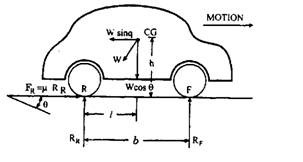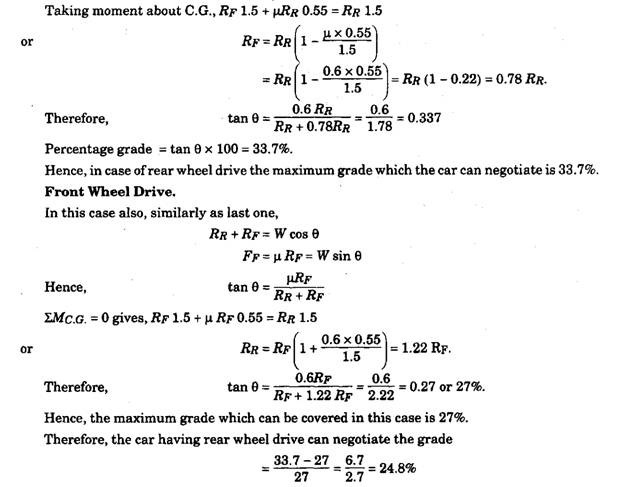31.8.
Distribution of Weight
31.8.1.
Three-wheeled Vehicle
The forces acting on vehicle at rest are shown in Fig. 31.5. Where, W = weight of the vehicle, N 6 = wheel base, m
I = distance of C.G. from the rear axle, m h = height of C.G. from the road surface, m
c = distance of C.G. from the central axis, m
a = wheel track, m Rf = vertical reaction at the front wheel, N Rri, RR2 = vertical reaction at the rear wheels, N There are three unknowns which can be determined as follows Moment about rear axle gives,


Fig. 31.5. Forces acting on three-wheeled vehicle at rest.
![]()
Also W = Rf + Rri + RR2 must be satisfied and serves as an extra equation for alternative solution.
31.8.2.
Four-wheeled Vehicle
Forces acting on a four-wheeled vehicle at rest are shown in Fig. 31.6. In this case only three independent equations can be formed to take care of four unknown viz., four reactions at the wheels. Thus the problem is simplified by considering it as a two-wheeled vehicle i.e. the reactions on both rear wheels are equal and also on both front wheels. Let Rf and Rr be vertical reactions at front and rear wheel respectively,

Fig. 31.6. Forces acting on four-wheeled vehicle at rest.

Example 31.5. A car weighing 21336.75 N has a static weight distribution on the axles of 50:50. The wheel base is 3 m and the height of centre of gravity above ground above is 0.55 m. If the coefficient of friction on the high way is 0.6, calculate the advantage of having rear wheel drive rather than front wheel drive as far as gradiability is concerned, if engine power is not a limitation.

Rear Wheel Drive.
Considering the car moving at constant speed up a gradient of angle 9, the forces giving equilibrium are shown in Fig. 31.7.
Then, Rr+Rf= Wcos8
and, Fr = hRr = W sin 0
By division,
tan 9 = _ „ Rr + Rf

Fig. 31.7. Forces acting on a vehicle moving up a gradient.

which is more than the car having front wheel drive, so far as gradability is concerned.
